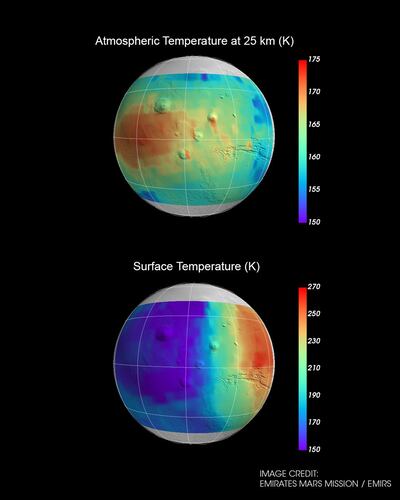The Emirates Mars Mission is moving into its next phase, gathering data that will help scientists to study the atmosphere and weather of the Red Planet.
The Hope probe, which started orbiting Mars on February 9, activated its instruments on April 10, and has already sent back thousands of images.
Now, the orbiter will spend two years collecting extensive data on gases, including hydrogen, oxygen and carbon monoxide, that surround the planet.
The data will help scientists to understand why and how Mars, which may have once supported ancient life, lost most of its atmosphere.
“Following a successful cruise to Mars, a near-perfect Mars orbit insertion manoeuvre and our transition from Hope’s capture orbit to our science orbit, we have completed our commissioning, calibration and testing phase,” said the project’s director, Omran Sharaf.
“I am delighted to be able to report that the Mars Hope probe is perfectly positioned to commence its two-year science mission.”
Recent images taken by the ultraviolet spectrometer, one of Hope’s instruments, shows sunlight reflecting off an extended cloud of atomic hydrogen gas that surrounds the planet.
Hope was able to capture the phenomenon because its unique 25-degree elliptical orbit allows it to study the planet at different times of the day.
The ultraviolet spectrometer has sent 14,000 spectral-spatial images of the atmosphere.
Sarah Al Amiri, Minister of State for Advanced Technology and Chairwoman of the UAE Space Agency, said it was capable of collecting "a lot of new data".
“The atomic hydrogen is formed by sunlight splitting water in the lower atmosphere, then diffuses to the upper atmosphere and escapes to space,” she said.
“The hydrogen is thickest close to Mars, circling the planet with a bright ring of light, and becomes thinner and dimmer further away.”
The spacecraft’s other instruments include an infrared spectrometer and the eXploration imager, a high-resolution camera.
The infrared spectrometer has been collecting data since the spacecraft’s arrival at Mars.
It will measure surface and atmospheric temperatures and gather data on ice, dust and water vapour.
A newly released image taken by the instrument shows the temperature of the planet.
"This Emirs [infrared spectrometer] image acquired on March 5 from an altitude of about 15,000km showcases the temperature in the same region at different altitudes," Ms Al Amiri said.

“In the surface temperature image, centred on the Tharsis region of Mars, dawn can be seen towards the right side.
“The low surface temperatures observed are due to the dusty nature of the Martian surface.
“An elevated night-time atmospheric temperature at 25km altitude is also observed over the Tharsis region.”
The eXploration imager has taken more than 500 images of the planet since the transition to science orbit took place in early April.
The imager is now mapping water ice clouds in the atmosphere as Mars enters its cloudy season.
A belt of clouds forms near the planet’s equator in the northern hemisphere during spring and summer, and the Hope probe will be able to measure it.









































